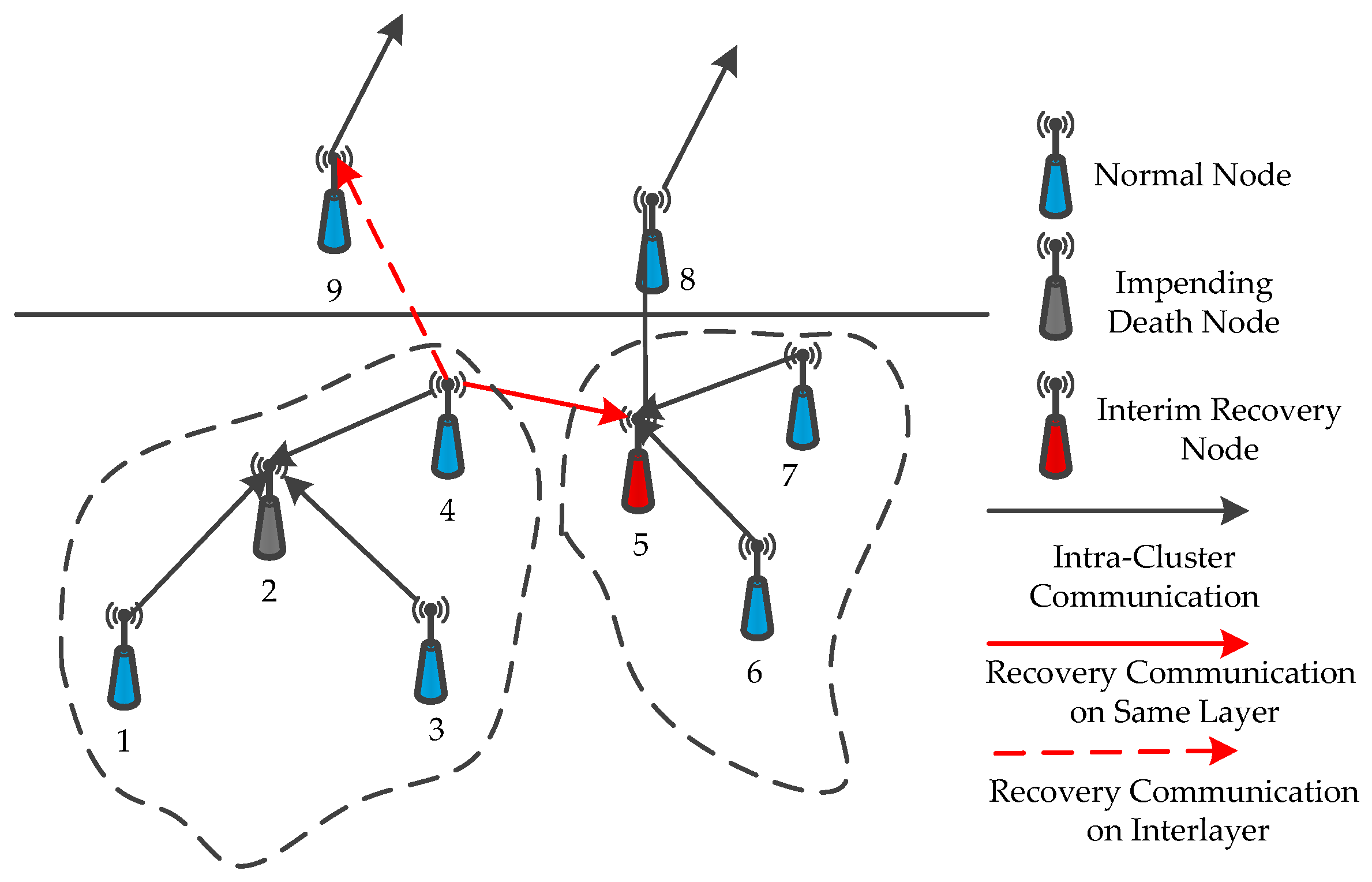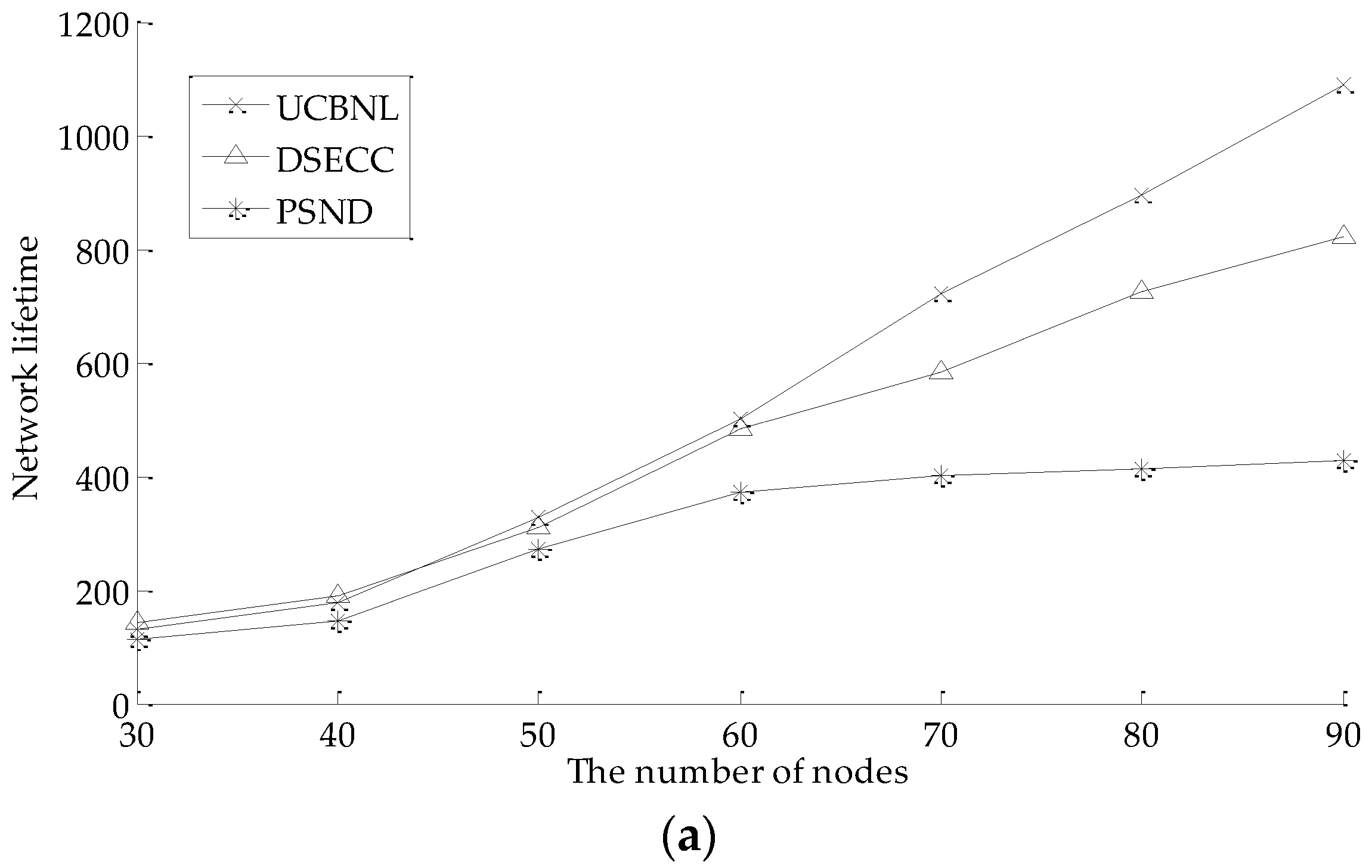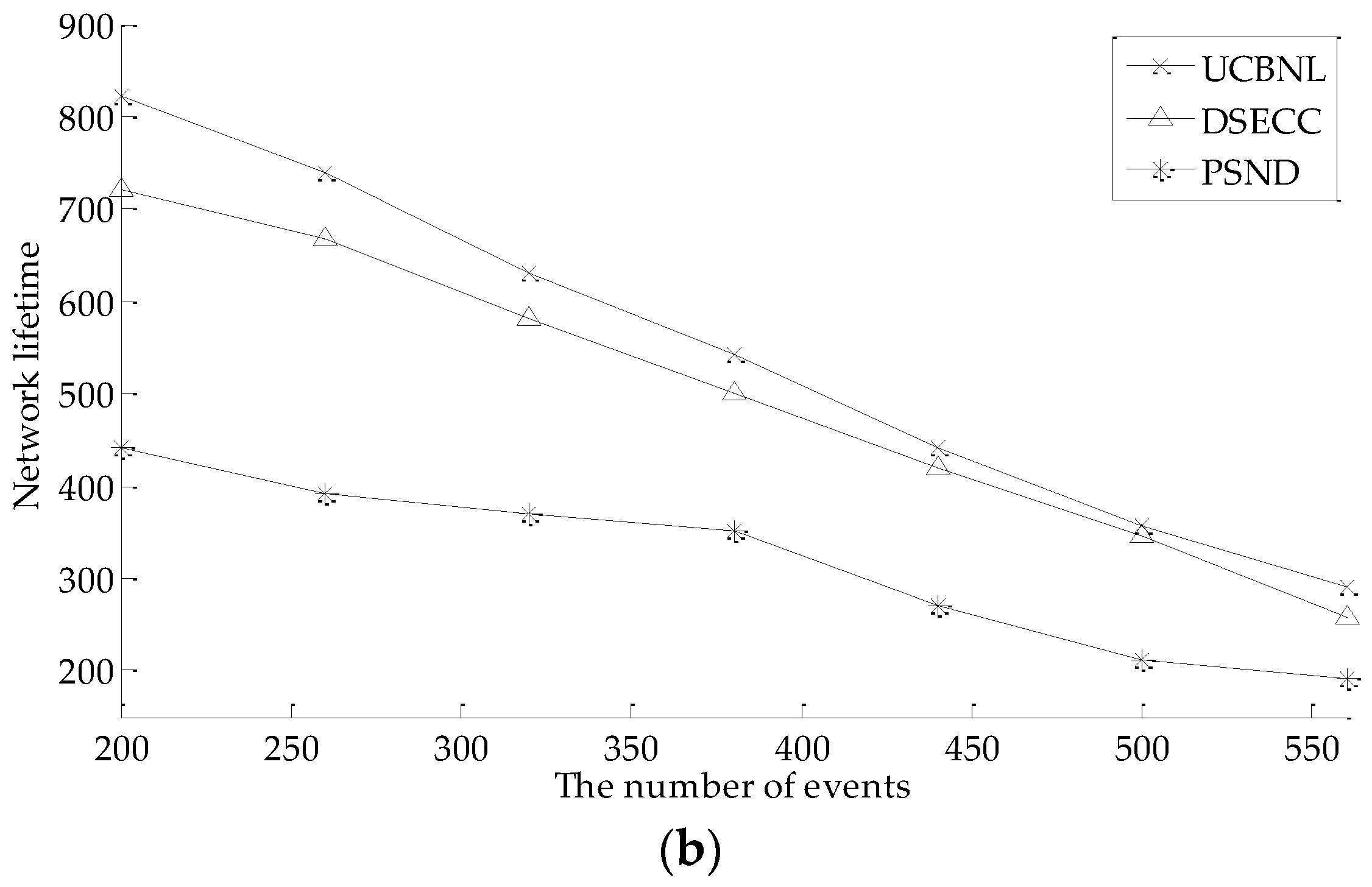A High-Efficiency Uneven Cluster Deployment Algorithm Based on Network Layered for Event Coverage in UWSNs
Abstract
:1. Introduction
- (1)
- The prior node distribution density of a layered network is derived, thus reducing the movement distance of node and balancing network energy consumption.
- (2)
- The adjustable communication radius model ensures that the network is fully connected at the initial process of network deployment. The network connectivity rate can be improved adaptively in the subsequent data acquisition.
- (3)
- The recovery strategy of clusters utilizes the node with maximum comprehensive advantage to help recover the death node, thus prolonging network lifetime and improving the efficiency of data acquisition.
2. Related Work
3. Models and Related Definitions
3.1. Models
3.1.1. UWSNs Models
- (1)
- Each node can perceive the self-depth information; thus, we can determine its layer number.
- (2)
- Each node has a unique ID. The nodes use unified underwater acoustic signals to communicate and acquire information. Sink nodes transmit the information to the base station by radio frequency signals. If acquisition information is sent to any sink node set on the water surface, then data acquisition is successful.
- (3)
- All nodes have the same initial energy Einit and sensing radius Rs (using the Boolean sensing model). The nodes are equipped with a transmission power control module [7] that can adjust the communication radius RC within a 5 m accuracy range that does not exceed a fixed threshold RCmax. Furthermore, the energy of the sink node is sufficient, and its energy consumption is negligible.
3.1.2. Node Perception Model
3.1.3. Node Energy Consumption Model
3.1.4. Adjustable Communication Radius Model
3.1.5. Node Mobility Model under the Influence of Water Flow
3.2. Related Definitions
3.2.1. Network Connectivity Rate
3.2.2. Network Coverage Rate
3.2.3. Network Lifetime
3.2.4. Network Reliability
3.2.5. Movement Coverage Gain
4. Problem Analysis and Algorithm Description
4.1. Problem Analysis
4.2. Algorithm Description
4.2.1. Interlayer Distance d and Deployment Expectation
4.2.2. Uneven Clustering Deployment Based on Event Distribution
- (1)
- In the monitored underwater environment whose volume is L × W × H, multiple sink nodes create a uniform linear layout on the water surface center line. Section 4.2.1 shows that we can obtain a total deployment expected number of nodes for network layer i. Then, all of the nodes adjust their depth randomly within the interlayer range, and the number of events distributed in the space is et.
- (2)
- The communication levels θ of all of the nodes in layer l are initialized to be 1. All communication node radii are Rc. All nodes in layer l broadcast the neighbor finding messages If and attempt to receive that message from other nodes in this layer network. If node i receives the neighbor finding message If from node j in the range of broadcast radius, then the same time node i must return a response message Ia to node j with the same communication radius. If node i cannot receive any neighbor finding message from all other nodes in its layer l, then node i is denoted as a state of neighbor barely. Thus, the node gradually increases the communication level θ to broadcast neighbor finding message If. The aforementioned process continues the iteration until all nodes in this layer network can receive response messages Ia. The neighbor node is defined by if node j can receive response message Ia from the network of layer l. If the response message Ia comes from a layer network above, then the neighbor node is defined by . We record the information of all of the nodes of each layer network by using the same principle until the overall network nodes can receive response message Ia. However, the nodes in the first layer network have no upper neighbor nodes; thus, its upper neighbor node information will not be labeled.
- (3)
- All nodes perceive their surrounding event and broadcast and receive cluster generation information Cg (contains the number of perceived events and the neighbor node information). Given that cluster head nodes have more energy consumption that leads to premature death, they will be a prior consideration. Node i selects the node that can perceive most events from its neighbor nodes (including itself) to be its cluster head to maintain the effective network coverage rate. If multiple neighbor nodes can perceive the same maximum number of events, then node i selects the node away from its nearest neighbor as its cluster head node.
- (4)
- After completing the previous steps, each cluster head node will collect event information and transmit data to sink node sets by the single-hop or multi-hop method. The cluster head node chooses the node (including the cluster head node and intra-cluster node) with maximum forwarding probability pj as its next-hop and the next-hop node in other clusters in the upper layer network. We can determine the forwarding probability pj by the following formula: pj = Δ/c, where we define the comprehensive advantage as . a and b is a regulatory factor, and a + b = 1, c is the number of neighbor nodes that the cluster head nodes can detect in their upper layer network. The intra-cluster node selects its cluster head node to form the next-hop path.
- (5)
- When the network undergoes many rounds (the number of data acquisition) or is affected by underwater current, volcanic eruption, or harbor and shore activities, the cluster head node may die prematurely and the network topology will change. Once the data transmission chain shows the phenomenon of “interlay disconnect”, then the data transmission will fail between adjacent layers. We need to select several proper relay nodes to substitute for the forwarding nodes out of service or to reselect the new cluster head node. The specific recovery strategy is as follows: When the data transmission fails in interlay network communication, the cluster head nodes select the cluster member node with a more relative residual energy as the temporary cluster head node. If the data transmission chain restores data acquisition in the interlay network, then the temporary cluster head node j is directly replaced as the real cluster head node; otherwise, the temporary cluster head node j detects neighbor clusters in the same layer and selects the nearest node in neighbor clusters away from node j to forward messages (as shown in Figure 5, node 2 is a cluster head of nodes 1, 3, and 4 when the energy of cluster head node 2 is almost exhausted. Node 2 initially attempts to select node 4 as the temporary cluster head with more relative residual energy . If the data transmission chain is still unable to connect, then the cluster head node 2 selects node 5 as its next-hop node at the neighbor cluster in the same layer network). If the two strategies still cannot achieve the data transmission, then we can conclude that the cluster has reached the threshold of death. We subsequently select other nodes to replace the original node that almost reached the threshold of death. Then, we recover the cluster. For the cluster that reaches the threshold of death, the cluster head node C(j) of node j determines the largest comprehensive advantage of node i in its cluster. If node i can recover the transmission chain by itself to substitute for node j, then determining the node i to move in a straight line to substitute for node j. If the transmission link is still disconnected, then the cluster head node searches all neighbor cluster nodes within the same layer and generates a report on all cluster generation information Cg of the nodes, including the number of events covered and depth information. Each neighbor cluster head node sends help message Hm (which may be several) to node j and selects the nearest node h to substitute for node i. If cluster head node C(j) cannot receive any help message, then the process of recovering fails. Furthermore, the overall algorithm description of uneven cluster deployment based on event distribution is shown in Figure 6.
5. Simulation Evaluation
5.1. Parameter Settings and Evaluation Metrics
5.2. Comparison and Analysis of the Simulation Results
5.2.1. Network Energy Consumption
5.2.2. Network Coverage Rate
5.2.3. Network Connectivity Rate
5.2.4. Network Lifetime
5.2.5. Network Reliability
6. Conclusions and Future Work
Acknowledgments
Author Contributions
Conflicts of Interest
References
- Garcia, M.; Sendra, S.; Atenas, M. Underwater wireless ad-hoc networks: A survey. In Book Mobile Ad Hoc Networks: Current Status and Future Trends; Loo, J., Mauri, J.L., Ortiz, J.H., Eds.; CRC Press: Boca Raton, FL, USA, 2011; pp. 379–411. [Google Scholar]
- Bhambri, H.; Swaroop, A. Underwater sensor network: Architectures, challenges and applications. In Proceedings of the IEEE International Conference on Computing for Sustainable Global Development, New Delhi, India, 5–7 March 2014; pp. 915–920.
- Prasan, U.D.; Murugappan, S. Underwater Sensor Networks: Architecture, Research Challenges and Potential Applications. Int. J. Eng. Res. Appl. 2012, 2, 251–256. [Google Scholar]
- Gkikopouli, A.; Nikolakopoulos, G.; Manesis, S. A survey on underwater wireless sensor networks and applications. In Proceedings of the IEEE Conference on Control and Automation (MED), Barcelona, Spain, 3–6 July 2012; pp. 1147–1154.
- Varughese, A.; Seetharamiah, P. Design of a Node for an Underwater Sensor Network. Int. J. Comput. Appl. 2014, 91, 36–39. [Google Scholar] [CrossRef]
- Hawbani, A.; Wang, X.F.; Husaini, N. Grid Coverage Algorithm & Analyzing for wireless sensor networks. Netw. Protoc. Algorithms 2014, 6, 1–18. [Google Scholar]
- Pinto, D.; Viana, S.S.; Nacif, J.A. HydroNode: A low cost, energy efficient, multi purpose node for underwater sensor networks. In Proceedings of the Conference on Local Computer Networks (LCN), Edmonton, AB, Canada, 8–11 September 2012; pp. 148–151.
- Vilela, J.; Kashino, Z.; Ly, R. A Dynamic Approach to Sensor Network Deployment for Mobile-Target Detection in Unstructured, Expanding Search Areas. IEEE Sens. J. 2016, 16, 4405–4417. [Google Scholar] [CrossRef]
- Virginia, P.; Luigi, A. Deployment of Distributed Applications in Wireless Sensor Networks. Sensors 2011, 11, 7395–7419. [Google Scholar] [Green Version]
- Temel, S.; Unaldi, N.; Kaynak, O. On deployment of wireless sensors on 3-D terrains to maximize sensing coverage by utilizing cat swarm optimization with wavelet transform. IEEE Trans. Syst. Man Cybern. Syst. 2014, 44, 111–120. [Google Scholar] [CrossRef]
- Venkateswaran, A.; Sarangan, V. A Mobility-Prediction-Based Relay Deployment Framework for Conserving Power in MANETs. IEEE Trans. Mob. Comput. 2008, 8, 750–765. [Google Scholar] [CrossRef]
- Li, H.; Yang, B.; Chen, C. Connectivity of Aeronautical Ad hoc Networks. In Proceedings of the IEEE Conference on GLOBECOM Workshops, Miami, FL, USA, 6–10 December 2010; pp. 1788–1792.
- Nguyen, T.T.; Dao, T.K.; Horng, M.F.; Shieh, C.S. An Energy-based Cluster Head Selection Algorithm to Support Long-lifetime in Wireless Sensor Networks. J. Netw. Intell. 2016, 1, 23–37. [Google Scholar]
- Dao, T.T.; Pan, T.T.; Nguyen, T.T.; Chu, S.C. A Compact Articial Bee Colony Optimization for Topology Control Scheme in Wireless Sensor Networks. J. Inf. Hiding Multimed. Signal Process. 2015, 6, 297–310. [Google Scholar]
- Ali, T.; Jung, L.T.; Faye, I. End-to-End Delay and Energy Efficient Routing Protocol for Underwater Wireless Sensor Networks. Wirel. Pers. Commun. 2014, 79, 339–361. [Google Scholar] [CrossRef]
- Pompili, D.; Melodia, T.; Akyildiz, I.F. Deployment analysis in underwater acoustic wireless sensor networks. In Proceedings of the 1st ACM international workshop on underwater networks, Los Angeles, CA, USA, 25 September 2006; pp. 48–55.
- Xia, N. Fish Swarm Inspired Underwater Sensor Deployment. Acta Autom. Sin. 2012, 38, 295–302. [Google Scholar] [CrossRef]
- Du, H.; Xia, N.; Jiang, J. Particle swarm inspired underwater sensor self-deployment. Sensors 2014, 14, 15262–15281. [Google Scholar] [CrossRef] [PubMed]
- Peng, J.; Liu, J.; Wu, F. Node Non-Uniform Deployment Based on Clustering Algorithm for Underwater Sensor Networks. Sensors 2015, 15, 29997–30010. [Google Scholar]
- Bharamagoudra, M.R.; Manvi, S.K.S. Deployment Scheme for Enhancing Coverage and Connectivity in Underwater Acoustic Sensor Networks. Wirel. Pers. Commun. 2016, 89, 1265–1293. [Google Scholar] [CrossRef]
- Huang, C.J.; Wang, Y.W.; Lin, C.F. A self-healing clustering algorithm for underwater sensor networks. Clust. Comput. 2011, 14, 91–99. [Google Scholar] [CrossRef]
- Cai, S.B.; Zhang, G.Z.; Liu, S.L. Weighted Localization for Underwater Sensor Networks. Lect. Notes Electr. Eng. 2014, 295, 325–334. [Google Scholar]
- Cheng, W.; Teymorian, A.Y.; Ma, L. Underwater Localization in Sparse 3D Acoustic Sensor Networks. In Proceedings of the 27th Conference on Computer Communications, INFOCOM 2008, Phoenix, AZ, USA, 13–18 April 2008; pp. 236–240.
- Han, G.; Zhang, C.; Shu, L. A survey on deployment algorithms in underwater acoustic sensor networks. Int. J. Distrib. Sens. Netw. 2013, 1–11. [Google Scholar] [CrossRef]
- Liu, L. A deployment algorithm for underwater sensor networks in ocean environment. J. Circ. Syst. Comput. 2011, 20, 1051–1066. [Google Scholar] [CrossRef]
- Alam, S.M.; Haas, Z.J. Coverage and connectivity in three-dimensional networks. In Proceedings of the 12th Annual International Conference on Mobile Computing and Networking, Los Angeles, CA, USA, 24–29 September 2006; pp. 346–357.
- Alam, S.M.N.; Haas, Z.J. Coverage and connectivity in three-dimensional networks with random node deployment. Ad Hoc Netw. 2015, 34, 157–169. [Google Scholar] [CrossRef]
- Akkaya, K.; Newell, A. Self-deployment of sensors for maximized coverage in underwater acoustic sensor networks. Comput. Commun. 2009, 32, 1233–1244. [Google Scholar] [CrossRef]
- Senel, F.; Akkaya, K.; Erol-Kantarci, M.; Yilmaz, T. Self-deployment of mobile underwater acoustic sensor networks for maximized coverage and guaranteed connectivity. Ad Hoc Netw. 2014, 34, 170–183. [Google Scholar] [CrossRef]
- Wu, J.; Wang, Y.; Liu, L. A Voronoi-Based Depth-Adjustment Scheme for Underwater Wireless Sensor Networks. Int. J. Smart Sens. Intell. Syst. 2013, 6, 244–258. [Google Scholar]
- Partan, J.; Kurose, J.; Levine, B.N. A survey of practical issues in underwater networks. ACM Sigmobile Mob. Comput. Commun. Rev. 2007, 11, 23–33. [Google Scholar] [CrossRef]
- Ahmed, S.; Javaid, N.; Khan, F.A. Co-UWSN: Cooperative Energy Efficient Protocol for Underwater WSNs. Int. J. Distrib. Sens. Netw. 2015. [Google Scholar] [CrossRef] [PubMed]
- Zhou, Z.; Peng, Z.; Cui, J.H. Scalable Localization with Mobility Prediction for Underwater Sensor Networks. IEEE Trans. Mob. Comput. 2010, 10, 2198–2206. [Google Scholar]
- Bahi, J.; Haddad, M.; Hakem, M. Efficient distributed lifetime optimization algorithm for sensor networks. Ad Hoc Netw. 2014, 16, 1–12. [Google Scholar] [CrossRef]
- Wahid, A.; Lee, S.; Kim, D. A reliable and energy-efficient routing protocol for underwater wireless sensor networks. Int. J. Commun. Syst. 2014, 27, 2048–2062. [Google Scholar] [CrossRef]
- Saxena, S.; Mishra, S.; Singh, M. Clustering Based on Node Density in Heterogeneous Under-Water Sensor Network. Int. J. Inf. Technol. Comput. Sci. 2013, 5, 49–55. [Google Scholar] [CrossRef]














| Parameter | Value |
|---|---|
| Initial energy of node Einit | 1000 J |
| Energy threshold of node Eth | 20 J |
| Coverage threshold Cth | 0.1 |
| Energy consumption on unit moving distance mu | 1 J/m |
| Power threshold P0 | 0.05 W |
| Transmission delay Tp | 0.2 s |
| Energy spreading factor k | 2 |
| Carrier frequency f | 24 kHz |
| Sense radius of node Rs | 40 m |
© 2016 by the authors; licensee MDPI, Basel, Switzerland. This article is an open access article distributed under the terms and conditions of the Creative Commons Attribution (CC-BY) license (http://creativecommons.org/licenses/by/4.0/).
Share and Cite
Yu, S.; Liu, S.; Jiang, P. A High-Efficiency Uneven Cluster Deployment Algorithm Based on Network Layered for Event Coverage in UWSNs. Sensors 2016, 16, 2103. https://doi.org/10.3390/s16122103
Yu S, Liu S, Jiang P. A High-Efficiency Uneven Cluster Deployment Algorithm Based on Network Layered for Event Coverage in UWSNs. Sensors. 2016; 16(12):2103. https://doi.org/10.3390/s16122103
Chicago/Turabian StyleYu, Shanen, Shuai Liu, and Peng Jiang. 2016. "A High-Efficiency Uneven Cluster Deployment Algorithm Based on Network Layered for Event Coverage in UWSNs" Sensors 16, no. 12: 2103. https://doi.org/10.3390/s16122103





